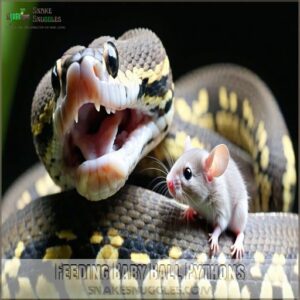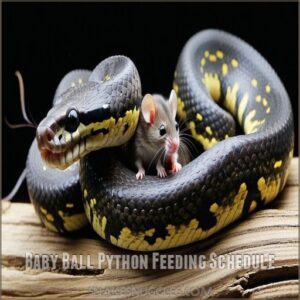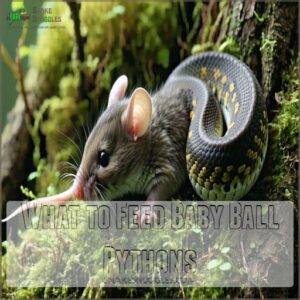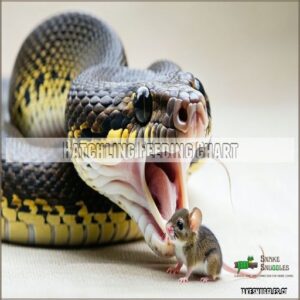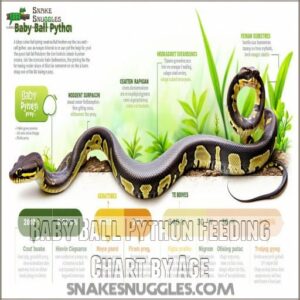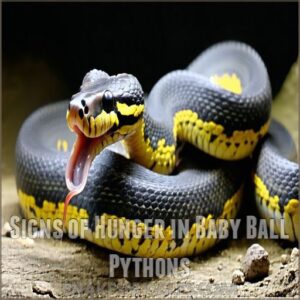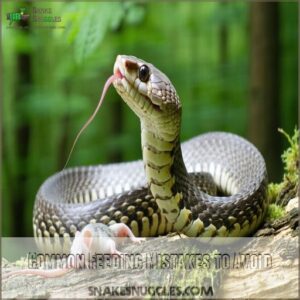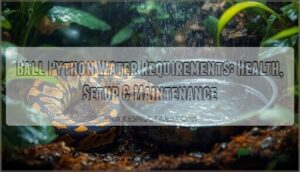This site is supported by our readers. We may earn a commission, at no cost to you, if you purchase through links.
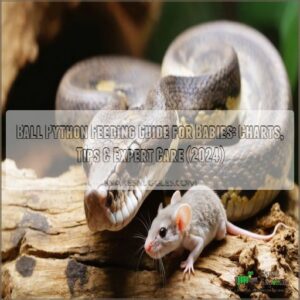
Feed them every 5-7 days during their first three months, then adjust to 7-10 days as they grow.
Always use frozen-thawed prey warmed to 100-110°F, and never microwave it.
Just like a growing child needs the right portion sizes, your snake’s meals should grow with them. Getting these basics right sets up your snake for a lifetime of healthy eating habits. There’s more to mastering feeding techniques than meets the eye. Always use frozen-thawed prey. Your snake’s meals should grow with them.
Table Of Contents
- Key Takeaways
- Feeding Baby Ball Pythons
- Baby Ball Python Feeding Schedule
- What to Feed Baby Ball Pythons
- Ball Python Feeding Chart for Babies
- How to Feed Frozen Mice to Baby Ball Pythons
- Signs of Hunger in Baby Ball Pythons
- Common Feeding Mistakes to Avoid
- Supplements for Baby Ball Pythons
- Troubleshooting Feeding Issues in Baby Ball Pythons
- Conclusion
Key Takeaways
- You’ll need to feed your baby ball python every 5–7 days when young, gradually shifting to 7–10 days as they grow over 200 grams.
- Choose prey that’s 1–1.25 times your snake’s mid-body width, starting with hopper mice (7–12 g) for hatchlings and increasing size as they grow.
- You should always use frozen-thawed prey warmed to 100–110°F, never live prey, which can harm your snake.
- You can determine if your snake’s hungry by watching for increased tongue flicking and exploration, especially during evening hours.
Feeding Baby Ball Pythons
You’ll find that feeding your baby ball python isn’t rocket science once you understand the basics of prey size, types, and proper feeding techniques.
Whether you’re a first-time snake parent or an experienced keeper, this guide will help you create the perfect feeding routine that’ll keep your scaly friend healthy and thriving.
Choosing The Right Prey Size
Picking the right prey size for your baby ball python sets them up for healthy growth.
Choose prey that’s 1 to 1.25 times their mid-body width – never larger than their thickest point.
A digital kitchen scale is your best friend here.
For most hatchlings weighing 45-80g, start with hopper mice (7-12g).
As they grow, gradually size up their meals to match their increasing girth.
Prey Types for Baby Ball Pythons
Your baby ball python needs the right prey for proper growth.
While choosing prey size matters, the type of food makes all the difference.
Here are your best options:
- Frozen-thawed hopper mice (7-12g) for hatchlings
- Fuzzy rats (13-19g) once they reach 3 months
- Small adult mice (20-30g) at 6 months
Remember, stick with domesticated prey from reliable sources – wild-caught rodents can carry parasites and diseases.
Feeding Techniques for Baby Ball Pythons
Properly presenting prey to baby ball pythons requires careful attention to technique and timing. Here’s a detailed breakdown of essential feeding methods:
| Technique | Method | Tips |
|---|---|---|
| Thawing | Room temp water | Never microwave |
| Warming | Hot water dip | 100-110°F ideal |
| Presentation | Tongs only | 12" distance |
| Movement | Gentle wiggle | Mimic live prey |
| Timing | Evening/night | Natural cycle |
Always use feeding tongs and maintain proper distances.
Think of it like serving dinner to a tiny, scaly guest – they appreciate the right temperature and presentation!
Baby Ball Python Feeding Schedule
You’ll need to establish a regular feeding schedule for your baby ball python based on their age and weight to support healthy growth.
Your young snake needs more frequent meals than adults, starting with hopper mice every 5-7 days until they reach about 300 grams.
Feeding Frequency by Age
Setting up a reliable feeding schedule keeps baby ball pythons healthy and growing strong.
Just like human babies, these snakes need regular meals during their rapid growth phase.
Here’s what you need to know about age-based feeding:
- Hatchlings (0-3 months): Feed every 5-7 days
- Young juveniles (3-6 months): Feed every 7-10 days
- Older juveniles (6-12 months): Feed every 7-10 days
- Sub-adults (12-18 months): Feed every 10-14 days
Feeding Frequency by Weight
While monitoring your baby ball python‘s weight helps determine ideal feeding intervals, knowing exactly when to feed based on size helps maintain healthy growth.
Here’s a quick reference chart for feeding frequency by weight:
| Weight Range | Feeding Frequency |
|---|---|
| 50-100g | Every 5-7 days |
| 100-200g | Every 7 days |
| 200-350g | Every 7-10 days |
| 350-500g | Every 10-14 days |
| 500g+ | Every 14 days |
Keep in mind that these intervals might need adjustment based on your snake’s growth rate and appetite.
What to Feed Baby Ball Pythons
You’ll want to start your baby ball python on frozen-thawed mice that match their body size until they reach about 200 grams.
While rats will become their main diet later on, starting with appropriately sized mice helps make sure your baby snake develops healthy feeding habits.
Mice Vs Rats for Baby Ball Pythons
Now that you’ve got your feeding schedule down, let’s tackle a common question: mice or rats?
For baby ball pythons under 200 grams, mice are your best starting point. They’re easier to digest and the perfect size for your little noodle. You can also find more information on choosing the right ball python mouse size.
Once your python hits 200-300 grams, you’ll want to start mixing in rat pups. Just remember – the prey shouldn’t be wider than your snake’s widest point.
Other Prey Options for Baby Ball Pythons
Beyond mice and rats, you’ve got a few other prey options for your baby ball python.
Before you experiment, remember that consistency matters more than variety.
Here are the safe alternatives that work well for growing pythons:
- Quail chicks (perfect for pythons over 300g)
- African soft-furred rats (great for picky eaters)
- Hamster pups (only as a last resort)
Stick to captive-bred prey from reliable sources to keep your snake healthy.
Ball Python Feeding Chart for Babies
You’ll find feeding your baby ball python much easier with a proper feeding chart that matches prey size to your snake’s age and weight.
A good feeding chart works like a road map to help you track your snake’s growth and adjust meals at the right time.
So you won’t have to guess when it’s time to size up prey.
Hatchling Feeding Chart
Let’s start with the important feeding chart for your ball python hatchling.
Getting portion sizes right is necessary for healthy growth during these early stages, and remember to feed your baby ball pythons whole prey items that are no larger than 1.5 times the widest point of their body, as recommended for optimal baby ball python nutrition.
Here’s a quick reference guide that’ll help you nail those first few months of feeding:
| Hatchling Weight | Prey Size | Food Type | Feeding Interval |
|---|---|---|---|
| 45-60g | 7-8g | Hopper Mouse | Every 5 days |
| 61-70g | 9-10g | Hopper Mouse | Every 5 days |
| 71-80g | 11-12g | Hopper Mouse | Every 5 days |
| 81-120g | 13-15g | Small Mouse | Every 7 days |
Baby Ball Python Feeding Chart by Age
Your baby ball python‘s appetite matches their rapid growth, making a reliable feeding chart essential.
Think of it as your snake’s personal meal planner, helping you track their progress from hatchling to juvenile.
- Hatchlings (0-3 months): Feed hopper mice every 5 days
- Young juveniles (3-6 months): Offer fuzzy rats weekly
- Older juveniles (6-12 months): Switch to rat pups every 7-10 days
- Sub-adults (12-18 months): Graduate to small rats every 10-14 days
How to Feed Frozen Mice to Baby Ball Pythons
You’ll need to master the art of feeding frozen mice to your baby ball python since it’s safer than offering live prey that could hurt your pet.
Getting the thawing temperature just right at 100-110°F will make the difference between your snake striking enthusiastically or giving that mouse the cold shoulder.
Thawing and Warming Frozen Mice
Proper thawing transforms frozen mice into an appealing meal for your baby ball python.
For safe and effective thawing, consider purchasing products specifically designed for frozen mice thawing, such as those found in frozen mice thawing solutions.
Place the frozen mouse in a sealed plastic bag and thaw it in your refrigerator for 24 hours.
Once thawed, warm it to 100-110°F using warm water.
Never microwave or overheat the mouse – this can cause hot spots and burns.
Check the temperature with an infrared thermometer before offering it.
Presenting Frozen Mice to Baby Ball Pythons
Getting your baby ball python to accept thawed mice requires a strategic approach. Think of it as presenting a gourmet meal – the presentation matters!
Before presenting the mouse, make sure it’s completely thawed in cold water and gently warmed to approximately 90-100°F (32-38°C) for ideal safe feeding practices.
Here’s how to make that frozen mouse irresistible:
- Hold the mouse by its tail using feeding tongs
- Gently wiggle it to mimic natural movement
- Position it near your snake’s hide entrance
- If refused, try "braining" the mouse by making a small incision in the skull
Signs of Hunger in Baby Ball Pythons
You’ll need to watch for clear signs that indicate when your baby ball python is ready for its next meal, including active tongue flicking and increased exploration of its enclosure.
Just like a curious toddler at dinnertime, your snake will show increased activity and interest in its surroundings when it’s hungry, especially during the evening hours when these nocturnal hunters naturally want to feed.
active tongue flicking and increased exploration are key indicators.
Recognizing Hunger Cues
Knowing when a baby ball python is hungry helps maintain a healthy feeding schedule.
Watch for these reliable signs that indicate your snake is ready for its next meal:
| Behavior | Meaning | Action Needed |
|---|---|---|
| Tongue flicks increase | Active searching | Check feeding schedule |
| Prowling at dusk | Hunting mode | Prepare prey if due |
| Head raised, alert | Heightened awareness | Monitor closely |
These hunting behaviors typically start 1-2 days before their usual feeding time.
How Often to Feed Baby Ball Pythons
You’ll need to feed your baby ball python every 5-7 days during their first year of life.
As they grow, you can adjust this schedule based on their weight and eating patterns.
Keep track of their meals using a simple feeding log – it’s like maintaining a baby book for your snake! If they’re steadily gaining weight and shedding regularly, you’re right on track.
Common Feeding Mistakes to Avoid
You’ll want to avoid common feeding mistakes that can harm your baby ball python’s health and growth.
Even experienced snake owners can get thrown off by feeding schedules or prey sizes, but you’ll find it’s easier to get it right when you know what to watch for.
Overfeeding Baby Ball Pythons
While watching your baby ball python grow is exciting, overfeeding can lead to serious health issues. For guidance on proper feeding, consider checking a reliable ball python feeding chart.
Think of it like an all-you-can-eat buffet gone wrong.
Here’s what happens when you feed too much:
- Stomach problems and regurgitation from oversized meals
- Obesity that strains internal organs
- Irregular shedding patterns from rapid growth
- Shortened lifespan due to metabolic stress
Keep meals appropriately sized and stick to the recommended feeding schedule.
Underfeeding Baby Ball Pythons
Three key signs reveal if you’re underfeeding your baby ball python: stunted growth, frequent incomplete sheds, and visible weight loss.
Don’t let your snake’s health suffer – track their weight weekly and adjust portions if they’re losing mass.
Regular feeding keeps their immune system strong and prevents lethargy. Remember, younger snakes need food more often than adults, typically every 5-7 days for ideal health. Regular feeding is crucial.
Feeding Baby Ball Pythons Live Prey
Feeding live prey to baby ball pythons puts them at serious risk. Those cute little mice and rats can actually fight back, causing severe injuries or even death to your snake.
When considering feeding options, remember that frozen-thawed rodents are safer and more convenient.
Instead of gambling with your pet’s safety, stick to frozen-thawed prey. It’s not just safer – it’s more convenient, cost-effective, and gives you complete control over the feeding process. Your snake won’t know the difference.
Supplements for Baby Ball Pythons
You’ll need to understand supplements for your baby ball python since they can help prevent health issues in captivity.
While healthy ball pythons generally don’t need extra supplements if you’re feeding whole prey items, you’ll want to add calcium and vitamin D3 if you’re not using UVB lighting in your setup.
Do Baby Ball Pythons Need Calcium Supplements?
Your baby ball python gets most nutrients from whole prey, but sometimes needs extra calcium – especially without UVB lighting.
- Dust prey items with calcium powder once every 2-3 feedings
- Use a pure calcium supplement without phosphorus
- Avoid over-supplementing which can cause health issues
- Watch for signs of deficiency like tremors or weak muscles
Do Baby Ball Pythons Need Vitamin D3 Supplements?
Like calcium, Vitamin D3 plays a key role in your baby ball python’s health when UVB lighting isn’t available.
The good news? You don’t need to stress about D3 supplements if you’ve got proper UVB lighting set up.
Without UVB, you’ll want to dust prey items with a D3 supplement once every 2-3 feedings to help maintain strong bones and prevent metabolic issues.
Troubleshooting Feeding Issues in Baby Ball Pythons
When your baby ball python refuses to eat you’ll need to check their habitat conditions and try different feeding techniques to get them back on track.
You can usually solve feeding problems by adjusting factors like temperature, humidity, prey size, and feeding time.
while staying patient since healthy ball pythons can go several weeks without eating.
What to Do if Your Baby Ball Python Won’t Eat
When a baby ball python stops eating, staying calm is important since they can survive months without food.
Before panic sets in, check these essential factors:
- Ambient temperatures in both warm and cool zones
- Humidity levels throughout the enclosure
- Recent handling frequency or environmental changes
- Signs of illness like respiratory issues or mouth rot
If your baby ball python has lost 10-15% of its body weight, it’s time to explore force-feeding techniques, such as those used to assist with feeding refusal.
If the fast extends beyond 6-8 weeks, think about scheduling a vet visit.
How to Encourage Your Baby Ball Python to Eat
Getting a hesitant baby ball python to eat takes some detective work.
Try switching up your approach by offering prey at night when they’re naturally more active.
Bump up the enclosure’s temperature slightly, and experiment with scent transfer techniques – rubbing prey against successful feeders can work wonders.
Switch between different colored mice, or try varying prey sizes. Sometimes a smaller meal proves more tempting.
Conclusion
Who knew a ball python feeding guide for babies could be so detailed?
With these expert tips and charts in hand, you’re ready to give your baby ball python the precise nutrition it needs.
Remember to adjust prey size as your snake grows, stick to a consistent feeding schedule, and always prioritize safety with frozen-thawed prey.
By following this complete feeding guide, you’ll raise a healthy, thriving ball python that’ll be your companion for years to come.

